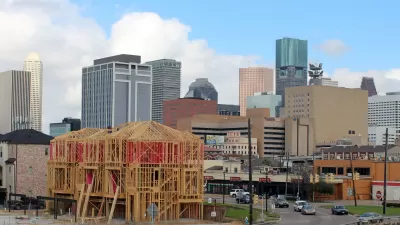Before 20th century urban renewal programs, U.S. cities were often overcrowded fire hazards and breeding grounds for tuberculosis and other airborne diseases. However, many of these programs also did severe damage. Is there a better way?
Nothing provides perspective like travel. China has some of the most dense cities in the world. Jim Chappell, former Executive Director of the San Francisco Planning and Urban Research think tank, recently took a trip to China. He was envious of the free civic museums in each Chinese city, which explained and documented the planning and development history of the city. He was also reminded that urban renewal, now a phrase with a strong negative connotation—so much so that the repeal of California's redevelopment law was welcomed from many corners—had its origin in real urban problems. Yet urban renewal, and its heir, redevelopment, created its own problems. Writes Chappell:
A few days in Asia and a few hours in the Hong Kong Museum of History reminded me that the issues urban renewal was addressing were also very real in America, as they were in Hong Kong. The problems with urban renewal cannot be dismissed as simply “racism” on the part of the elites or arrogance on the part of planning professionals. The problems they were addressing, including disinvestment and capital flight from cities, were difficult and complex. We don’t live in fear of massive urban fires or pestilence. It probably is really not necessary to wear a mask. But in the process, we destroyed vibrant communities and created a legacy of sorrow and dysfunction that permeates neighborhoods of our cities.
For more of Chappell's thoughts on urban renewal here and in China, please see the source article.
FULL STORY: Why we had Urban Renewal

Maui's Vacation Rental Debate Turns Ugly
Verbal attacks, misinformation campaigns and fistfights plague a high-stakes debate to convert thousands of vacation rentals into long-term housing.

Planetizen Federal Action Tracker
A weekly monitor of how Trump’s orders and actions are impacting planners and planning in America.

In Urban Planning, AI Prompting Could be the New Design Thinking
Creativity has long been key to great urban design. What if we see AI as our new creative partner?

King County Supportive Housing Program Offers Hope for Unhoused Residents
The county is taking a ‘Housing First’ approach that prioritizes getting people into housing, then offering wraparound supportive services.

Researchers Use AI to Get Clearer Picture of US Housing
Analysts are using artificial intelligence to supercharge their research by allowing them to comb through data faster. Though these AI tools can be error prone, they save time and housing researchers are optimistic about the future.

Making Shared Micromobility More Inclusive
Cities and shared mobility system operators can do more to include people with disabilities in planning and operations, per a new report.
Urban Design for Planners 1: Software Tools
This six-course series explores essential urban design concepts using open source software and equips planners with the tools they need to participate fully in the urban design process.
Planning for Universal Design
Learn the tools for implementing Universal Design in planning regulations.
planning NEXT
Appalachian Highlands Housing Partners
Mpact (founded as Rail~Volution)
City of Camden Redevelopment Agency
City of Astoria
City of Portland
City of Laramie





























